The USB hubs, more commonly known as USB hub, allow to draw from a computer limited in USB ports. The USB hub is mainly used on laptops that suffer from limited space for connections, especially USB ports. But nothing prevents you from using a USB hub with a fixed computer. Wondering which are the best USB hubs for data transfer, connecting peripherals or expanding the available ports? Read this guide!
Here is our commitment, to make sure that we provide the best user experience and content quality:
You can support us by using our links to make your purchases (at no extra cost to you)! This sometimes earns us a commission which allows us to remain independent. More about us
Our selection
"We open the comparison with the Sabrent, a USB 3.0 hub with power switches that connects a wide range of USB devices to a SuperSpeed…"
"Despite its entry-level positioning, the Anker USB 3.0 hub has many qualities. It takes advantage of Anker's technological innovations to perfect its manufacturing quality."
"The Anker AK-A83340A1 allows you to configure just about any of its ports, including its 4K HDMI. This makes it THE perfect USB-C hub for…"
"It's not the most compact on the market, but it's still a very good choice if you need a lot of USB 3.0 ports. It…"
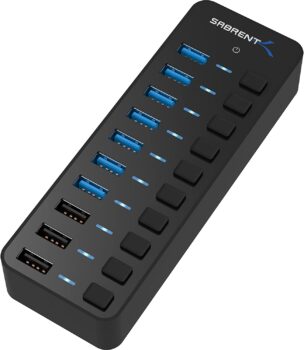
We open the comparison with the Sabrent, a USB 3.0 hub with power switches that connects a wide range of USB devices to a SuperSpeed hub.
34,39 £ on AmazonThe Sabrent USB 3.0 hub's sleek design and durable construction give it a long life. It's a useful travel companion. Note that this USB hub works with a USB Type-A host connector and provides you with 7 USB 3.0 ports and 3 smart charging ports with charging speed up to 2.4A.
The plug and play installation makes it easy to configure the hub. There are no drivers or software to install, making the process quick and easy. Each port has its own power switch. This allows you to conserve power and extend the life of your various devices by not overusing them while plugged into the hub.

Despite its entry-level positioning, the Anker USB 3.0 hub has many qualities. It takes advantage of Anker's technological innovations to perfect its manufacturing quality.
14,39 £ on AmazonWith the Anker USB 3.0 hub, you'll save space on your desk. Indeed, this model has an incredibly compact design. This Anker hub offers 4 SuperSpeed USB 3.0 ports that will allow you to transfer your data at blazing speeds of up to 5 Gbps. That's fast enough to transfer an HD movie in seconds.
This USB hub takes advantage of Anker's proprietary Extra Tough technology for incredible heat resistance and durability.. It also has a damage-resistant cable. So no matter how you bend or twist, this cable will stay firmly connected to the USB hub even when packed in a bag.
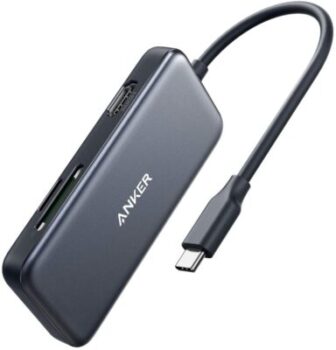
The Anker AK-A83340A1 allows you to configure just about any of its ports, including its 4K HDMI. This makes it THE perfect USB-C hub for those who need a variety of ports for their devices.
39,99 £ on AmazonIn terms of design and build quality, the Anker AK-A83340A1 USB-C hub impresses. It's hard to tell otherwise given its matte gray aluminum shell on top and dark gray polycarbonate underneath. For connectivity, you will be entitled to 5 expansion ports for your computer and mobile devices (tablets, smartphones, card readers ...).
No need to worry about connecting a multitude of external devices at the same time. The Anker AK-A83340A1 has a 4K HDMI port at 30 Hz, 2 USB 3.0 ports, 1 SD card reader and a micro SD card reader. Simply put, this USB hub is the best Anker has in stock. A reference of its kind.
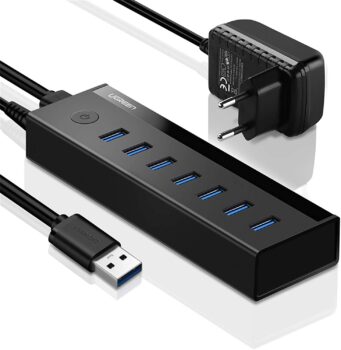
It's not the most compact on the market, but it's still a very good choice if you need a lot of USB 3.0 ports. It comes with a dedicated power supply and is plug-and-play on Windows, Mac and Linux.
31,99 £ on AmazonAny specific needs?
A USB hub for those with lots of devices to connect
Your guide :
Rate this buying guide :By rating this buying guide, you are helping us to reward our best writers. Thank you!
| TOP OF THE TOP | CHEAP | TOP OF THE LINE | EXCELLENT | |

In accordance with our commitment, this buying guide does not contain any sponsored products. |
 9/10 |
 8/10 |
 9/10 |
 8/10 |
| OUR SELECTION |
Sabrent USB 3.0 Hub
|
Anker USB 3.0 Hub
|
Anker USB Hub AK-A83340A1
|
Hub USB 3.0 UGREEN
|
|
We open the comparison with the Sabrent, a USB 3.0 hub with power switches that connects a wide range of USB devices to a SuperSpeed hub.
|
Despite its entry-level positioning, the Anker USB 3.0 hub has many qualities. It takes advantage of Anker's technological innovations to perfect its manufacturing quality.
|
The Anker AK-A83340A1 allows you to configure just about any of its ports, including its 4K HDMI. This makes it THE perfect USB-C hub for those who need a variety of ports for their devices.
|
It's not the most compact on the market, but it's still a very good choice if you need a lot of USB 3.0 ports. It comes with a dedicated power supply and is plug-and-play on Windows, Mac and Linux.
|
|
|
Type
|
Powered
|
Unpowered
|
Unpowered
|
Powered
|
|
USB standard
|
USB-A 3.0
|
USB-A 3.0
|
USB-C 4K
|
USB-A 3.0
|
|
Number of ports
|
10
|
4
|
4
|
7
|
|
Length of connecting cable
|
60 cm
|
60 cm
|
15 cm
|
100 cm
|
|
Dimensions (L x W x H)
|
14.5 x 4.8 x 2.4 cm
|
10.7 x 3 x 1 cm
|
11.6 x 4 x 5.9 cm
|
15 x 4.8 x 2.4 cm
|
Help us improve this table:
Report an error, request the addition of a feature to the table, or suggest another product. Thank you for your kindness!
We spend thousands of hours each year studying the major specialized websites, analyzing products of hundreds of brands and reading user feedback to advise you on the best products.
We are a product review company with a single mission: to simplify your buying decisions. Our research and testing helps millions of people every year find the best products for their personal needs and budget.
To support us you can: use our links to make your purchases (which often earns us a small commission), share our articles on social networks, or recommend our site on your blog. Thanks in advance for your support!
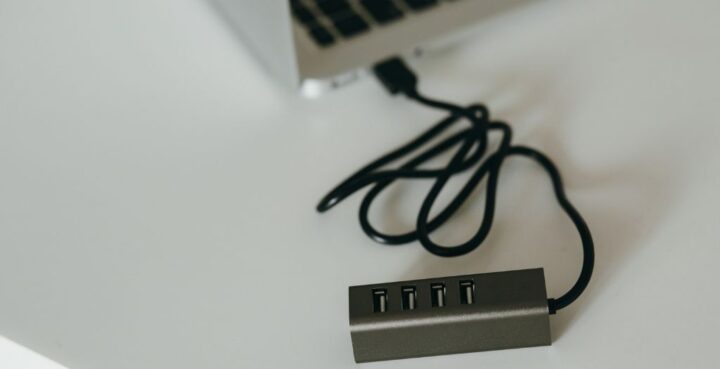
This may sound a little condescending, but it's a good idea to think beyond what you need in terms of number of ports. For example, let's say you hate the touchpad and keyboard on your laptop. So, you naturally assume that you need a hub with two ports: one for the mouse and one for the keyboard.
But take some time to think before you buy. Do you use a USB stick or external hard drive to transfer data? If so, is there another USB port on your laptop that you can use for this? If not, consider getting a model with more than two ports. That way, you don't have to unplug the keyboard or mouse to use your external storage device.
Whenyou buy a hub, you can choose between one that runs on power from the main port or one that uses an external power source. The former may seem more tempting; after all, these models are often cheaper than those with a power outlet.
However, think about what you're plugging in before you buy a hub without an external outlet. Each of your devices draws a specific amount of power from the USB port. When you convert a port to a hub, the total power limit of the computer's port is divided among the hub's ports. This means that if you overload a hub that has no external power, some of the devices in the hub will not work. You can check the power the hub can handle in its product description; it will be a number followed by "mA". This will usually be around 500mA for a self-powered hub.
Speaking of powering the hub, take some time to think about how you'll use it. Let's say you want the hub to power or charge your devices when the PC or computer is off. If you get an externally powered hub, you can charge your gadgets whether your PC is on or off. You may have a PC or laptop that can still charge devices when it is turned off, in which case you can probably forgo the external plug.
Make sure youtake a look at the version of ports on the hub itself. Some hubs will use USB 2.0 to cut costs, but that will result in slower data transfer for USB 3.0 devices. Of course, if all your devices use USB 2.0, that's fine! If you have devices that support USB 3.0, however, it's worth paying a little extra for a compatible hub.
Traditionally,connecting the hub to the host uses a Type A connector, but these days, USB Type C is widely used on new computers and other electronics. Make sure the USB hub has the right type of connector for your computer. USB-A is that large rectangular connector that has been used for many years. USB-C is much smaller and has rounded corners. It can also be connected in both directions and is not polarized in the same way as USB-A.
In terms of performance, the USB-C connector is meant to be used with USB 3.0 and higher standards that offer much faster operation than the older USB 1.0 and USB 2.0 standards. Fortunately, USB-A to USB-C adapters are available if needed, but it's always best to have the right connector.
The majority of modern peripherals that you want to connect to your computer are equipped with a USB connector. Most computers have a limited number of USB ports that can be used simultaneously. This can become a problem if you have several devices that you want to connect to your machine at the same time.
You may want to use a keyboard, scanner, printer and external hard drive to get your work done. You may also want to charge your phone while you work. You can swap devices in and out of the limited number of USB ports on your computer, but this can become frustrating and unproductive. There has to be a better way to use your devices.
This problem is solved by using a USB hub to provide additional USB ports to your system. A USB hub extends the capabilities of your machine, allowing it to interact with multiple USB devices simultaneously. It is a piece of equipment that provides multiple USB ports that all communicate with your computer through a single USB connector.
A USB hub will allow you to be more productive by eliminating the need to swap cables to access different devices. No matter how many USB ports are built into your machine, a USB hub will allow you to increase the number of devices you can support simultaneously.
The USB 1.0 port was introduced in 1996. Then the 2.0 port was developed in 2000. Today, we have the USB 3.0 which is a significant improvement over the 2.0 version. The 3.0 port was developed in 2008 and is still being modified by computer manufacturers today to increase the transfer rate as well as the current transmission power.
Today, the 3.0 version is almost 10 times faster than USB 2.0. There is also a 3.1 version which is specially used to transfer data at high speed. To use a 3.1 port, you must have compatible devices.
Most laptops and computers will have both 2.0 and 3.0 ports built in. The 2.0 port is usually used to power the mouse or keyboard because these devices do not require much power to operate.
This is because there is not enough power for the hubs or the peripherals connected to them. To connect two hubs together, at least one hub must be self-powered. For this reason, you cannot connect an Apple USB keyboard to the USB port of another Apple USB keyboard. If you want to use two bus-powered hubs with your computer, connect each to a USB port on the computer or to a self-powered hub.
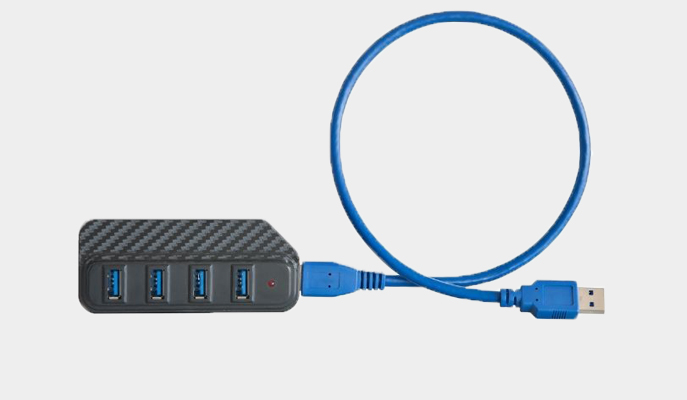
This type of USB hub plugs into the host computer's USB port and draws power from the main USB port upstream. The power consumed must be fed to the hub's circuitry, and then any available power is shared among the hub's output ports. This means that it is not normally possible to connect a portable CD/DVD drive or an external hard drive, which require higher power output. There is not enough power from a USB port in a non-powered USB hub. Non-powered USB hubs are limited in the number of ports primarily due to power limitations.

Powered USB hubs have an external power adapter and power for the hub ports comes from the power adapter. This allows items such as external CD/DVD drives or external hard drives to be connected via the hub. This configuration allows powered USB hubs to bypass port count limitations. Some powered USB hubs can have ten or more output ports, some with different interfaces like HDMI, VGA, Ethernet, etc.
...there is not enough power for the hubs or the devices connected to them. To connect two hubs together, at least one hub must be self-powered. For this reason, you cannot connect an Apple USB keyboard to the USB port of another Apple USB keyboard. If you want to use two bus-powered hubs with your computer, connect each to a USB port on the computer or to a self-powered hub.
USB hubs increase the number of ports on your device. Whether it's a USB-A hub or a USB-C hubhubs work like splitters to allow you to connect multiple devices to a single port. These hubs usually draw power from the laptop or PC itself and their light weight and small size make them easy to carry around.
Indeed, while modern ultra-thin laptops often lack USB ports, a hub is also useful with a desktop computer. Some PCs simply don't have enough built-in ports, while others place the various ports on the back of the CPU, making them difficult to access. Connecting a quality USB hub means you can keep those ports right on your desk within easy reach.
The USB docking station or dock combines many types of connections into one device. The number and type vary from station to station. Your laptop or PC becomes the brains of a complete workstation and the dock handles all the adaptations and conversions so you don't have to worry about carrying around several different standalone adapters.
Docking stations can provide a variety of video output types (such as VGA, DVI, HDMI, or DisplayPort) to connect external displays, as well as additional USB ports (USB-A, USB-C, etc.). You can also find Ethernet ports to support fast, wired network connections and the ability to charge or power one or more other devices.
USB hubs are the ideal solution for extending the power of your existing ports, whether on a laptop or PC. They are plug and play and ensure that there is always a port available to connect and/or charge another device. A USB hub is especially useful alongside a super slim laptop that only has a USB-C or Thunderbolt port.
USB docks turn your laptop into a true PC, offering full connectivity. This allows you to use any display as a 4K extended monitor, wire up a reliable internet connection, printer, and more. A dock is like adding a second engine to your laptop.

While there are laptops with many USB ports, many only have two or even one. This limited number of ports is really not great in today's USB-saturated landscape. If you're using a USB keyboard and mouse, you don't have any other ports to connect peripherals, such as an external hard drive, flash drive or printer. You'll have to remove the keyboard. That's the whole point of a USB hub: to give you extra ports.
A USB hub is useful for connecting several different devices to your computer at once. While non-powered USB hubs must be plugged into your computer to do this, powered hubs use a power outlet instead. This allows you to charge as many devices as you want, whether your computer is on or off.
This is one of the rarer types of USB hub use, but it's still very valid. If you find yourself in a situation where you need to move a lot of data between several different devices, a USB hub can be very useful. Again, this is certainly not a common situation for most people, and would only warrant a USB hub if it happens regularly. You never know!
MacBooks need a lot of power to maintain their fast processing speed. That's why connecting a non-powered USB hub severely limits their capacity. If you're only using one or two USB sticks, this may not affect your speed. But connecting multiple large components can be very stressful on your MacBook's hardware.
One problem with non-powered USB hubs is slow data transfer. If you're only transferring files occasionally, this won't be a problem, but if you're constantly rotating files from one device to another, it can definitely affect your transfer speed. By using a powered USB hub, you can dramatically speed up data transfers from minutes to seconds.
In our opinion, the best brands of USB hubs in 2022 are :
Anker is the world leader in charging technology. This includes wireless charging, car charging and USB hubs with transfer and fast charging ports. Anker is also the pioneer of power delivery technology.
Sabrent is one of the world's leading manufacturers of computer peripherals and accessories. Sabrent has consistently brought to market a full line of computer peripherals and accessories that incorporate style, quality and the latest technology available, and their USB hub is no exception.
UGREEN is a Chinese digital accessories brand owned by Ugreen Group Limited. Founded in 2012 UGREEN mainly manufactures digital accessories as well as charging and data transfer equipment, especially high quality Lightning cables and USB hubs.
iVanky was founded in May 2016. This company focuses on manufacturing audio/video cables, especially HDMI, with the aim of providing premium quality standard audio/video. The company also manufactures excellent USB hubs.
Belkin is an American consumer electronics and networking company headquartered in Playa Vista, California. It produces mobile connectivity devices and computer cabling for consumer and commercial use, including high-quality USB hubs.
The diagram below will help you to get an idea of the typical prices for each price range (entry-level, mid-range and high-end).
However, more expensive does not necessarily mean better.
We therefore advise you to always consult our ranking before deciding, rather than blindly relying on price ranges.
Always choose the latest USB standard
It may seem obvious to go with the latest USB standard, but even now, with USB 3.0 well established and the release of USB 4.0 approaching, there are still USB 2.0 hubs available. In fact, it's unlikely that there will be any USB 1.0 hubs available. USB 3.1 and 3.2 output offers a higher level of performance than USB 3.0.
Consider size and portability
Size and overall portability can be an issue. If the USB hub is to be used on the go, a small size and limited number of connections may be appropriate - non-powered USB hubs are limited to four connections. However, for home docking stations and the like, a powered USB hub and much higher levels of connectivity with more interfaces are the way to go.
Focus on versatility
SomeUSB hubs offer additional features such as fast charging, extra ports, and sometimes extra such as an SD card reader. If you only need the standard USB ports, it doesn't matter what else the hub offers. If you want something with a little more versatility, though, consider some of these extra features.
Check compatibility
All hubs are plug-and-play and hot-swappable. Plug-and-play means they can plug into most computers and you don't need to install drivers or third-party software. Hot eject means you can plug, unplug and remove USB devices while the hub is plugged into a computer, without needing to shut down or reboot the system. For added compatibility, it depends on the ports and features available. A USB-C port, for example, provides compatibility with Apple devices and other USB-C systems like some Chromebooks.
Check the safety devices
Power surge protection, undervoltage protection, and overload protection are all important, especially when multiple devices are connected to a USB hub simultaneously. These safety features are also important when transferring data, especially if a hard drive or USB stick is connected. A power surge can corrupt data and damage these devices.
There are several reasons why devices may not be compatible with a USB hub. Those without a dedicated power supply, for example, tend to provide less overall power, so some powered devices may have problems. Compatibility also depends on the power consumption of the device in question. If you're trying to plug in a printer, it probably won't work because it needs more power than a device like a mouse or keyboard.
Apart from a faulty port or hub, there are several reasons why some ports may not work. The device you are trying to connect may not be compatible or it may not have enough power. The port could be dirty and contain debris. Sometimes computers have trouble detecting certain USB devices, especially older systems.
The USB standard is backwards compatible, so USB 3.0 will work well with USB 2.0 or even USB 1.1. The older USB standards are limited by data transfer rates, so the lower the standard the longer the data transfers will take. For example, when you plug a USB 3.0 compatible external hard drive into a USB 2.0 port and initiate a data transfer, you will only see USB 2.0 transfer speeds of up to 480 Mbps instead of 5 Gbps.
Some gamers prefer to play PC games on a gaming laptop rather than a desktop computer. Since laptops are smaller than desktops, they usually don't have as many USB ports. A USB hub can not only give you more ports to connect peripherals (gaming mouse, gaming headset, etc.), but it can also give you more flexibility in how you connect your devices to avoid a cluttered gaming surface.
Every month we help more than 1 000 000 people buy better and smarter.
Copyright © 2022 - Made with ♥ by buyingbetter.co.uk
Your reviews and buying guides 0% advertising, 100% independent!